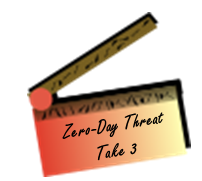The term “zero-day threat” may sound like the title of a blockbuster movie, but for organizations victimized by such threats, the story has anything but a happy ending. On the contrary, it’s typically a tale characterized by lost revenues, severely damaged reputations, and sometimes even costly litigation, regulatory fines and harsh court sanctions.
What are Zero-Day Threats?
In essence, zero-day threats earn their chilling designation because they strike without warning by exploiting hidden vulnerabilities in a computer application. On a specific day at a designated time, adversaries deploy zero-day exploits and attack — forcing developers to frenetically scramble and plug the security hole.
And to make matter worse, in many cases developers don’t even know that the security hole exists – or that an organization is under attack – until severe, lasting damage has been done.
Why Traditional Products Don’t Work and Cannot Detect Every Zero-Day Threat
The existence of looming zero-day threats begs a basic question: why don’t organizations protect themselves with anti-virus products? The answer is simple: they can’t.
While traditional anti-virus products are generally effective at identifying and blocking “known bad” samples, they can’t keep up with today’s rapidly increasing volumes of malware variants.
Furthermore, while traditional anti-virus products contain some degree of a host-based intrusion prevention system (HIPS), it’s a mistake to assume that all protection is created equal, as it will only be able to identify threats once active. These kind of features are usually inactive by default because of major false positives and significant CPU consumption.
And, unfortunately, signature-based network security technologies and general firewalls aren’t solutions, either. Signatures are reactive and fingerprint threats only after they’ve been identified. And general firewalls – even the sophisticated “next generation” kind – aren’t designed to handle unknown and blended zero-day threat attack patterns.
Given all of this, it would seem that adversaries hold the upper-hand, and that organizations – even those who have invested heavily in anti-virus products, signature-based network security technologies, and “next generation” firewalls – are proverbial “sitting ducks”, that can do nothing but anxiously hope that they aren’t the target of tomorrow’s zero-day attack.
Fortunately, that’s not the case for organizations that depend on Seculert.
Seculert: Post-Infection Detection
Frankly, there is no way to absolutely prevent zero-day threats. However, unlike traditional malware software that scans infection vectors, Seculert focuses on detecting the outcome of the zero-day exploit, which is malware and persistent threats communicating with the adversaries. This critical security breach information is then delivered via a constantly-updated web dashboard.
What’s more, Seculert runs entirely in the cloud, which means that when an advanced persistent threat is detected in one organization, all organizations benefit from the new, enhanced security information and protection.
Ultimately, is Seculert going to put adversaries, such as hacktivists, cyber criminals or nation-states, who develop and deploy zero-day threats “out of business”? Unfortunately, no.
However, organizations that rely on Seculert as part of their IT and network security system can know that adversaries won’t put them out of business with zero-day and persistent threats. And there’s really no way to put a price on that.
Try Seculert for FREE. Simple sign-up. No credit card required.




